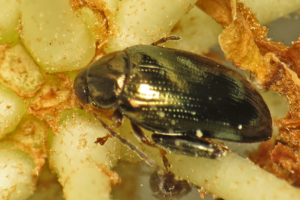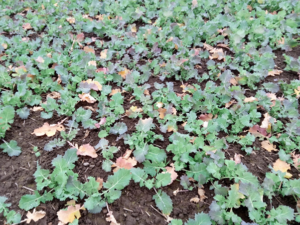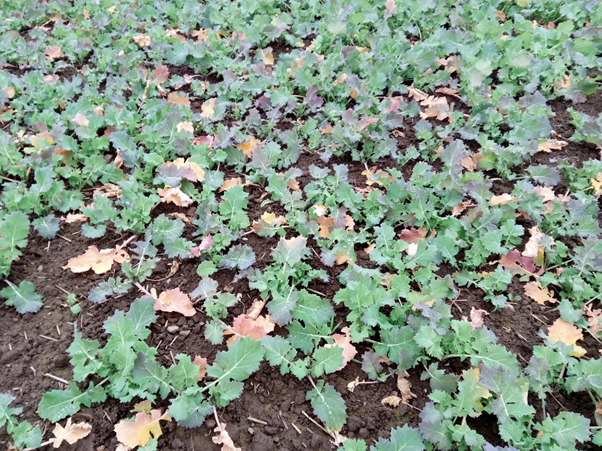Pest Challenges in Oilseed Rape
28 September 2019Oilseed rape crops have generally emerged well in moist warm soils, despite some being slightly later drilled than is the norm, and the acreage seems broadly similar to previous years. In recent years the number of pest challenges to the crop has increased and the key pests to consider in winter oilseed rape this autumn are flea beetle, cabbage stem flea beetle, peach-potato aphid (and turnip yellows virus – TuYV). Later in the autumn rape winter stem weevil is an additional pest to check for. Slugs are a perennial problem. Slug pellets can be more efficiently used as part of integrated methods so for example, fine seedbeds are helpful and slug pellets should only be used after bait testing to check the necessity. Metaldehyde has had a reprieve and ferric phosphate, which has equal efficacy, is the other option. Careful use of metaldehyde is a necessity to avoid contamination of water.
Flea beetle damage causes small holes in the cotyledons and the first true leaves of the emerging rape crop. The beetles are mainly active during dry soil conditions so, if feeding punctures are present on germinating plants, treatment with pyrethroids may be needed. Once three leaves have emerged, there is no need for treatment.
Cabbage stem flea beetles can also cause shot-holing of leaves, but in addition, they lay eggs near plants and the larvae burrow into the stem which can lead to winter kill, no stem elongation or lodging in spring. In Scottish crops, the adult beetle feeding damage tends to be worse than the larval damage. We have received several reports of cabbage stem flea beetle being seen on trailers during the harvest of this seasons winter oilseed rape. They will cause no harm to the seed if taken back into the store, but their presence is a ‘heads up’ that the beetle poses a threat on the farm to the next winter rape crop. As with the smaller flea beetles, pyrethroid insecticides (see list below) can be applied if the following damage thresholds for cabbage stem flea beetle have been exceeded:
>25 % of the leaf area damaged at the 1 to 2 true leaf growth stage
>50 % of the leaf area damaged at the 3 to 4 true leaf growth stage
Cabbage stem flea beetles in Scotland may have some resistance to pyrethroid insecticides, as resistance is widespread in English populations, and is a serious issue in English oilseed rape crops. Insecticide treatment should only be used if these damage thresholds have been exceeded but bear in mind that control may not be absolute due to resistance. SRUC would welcome any reports of poor flea beetle/cabbage stem flea beetle control this season as it will help to gauge the spread of resistance to pyrethroids in Scottish populations.
Peach-potato aphids may well be carrying turnip yellows virus (TuYV), which, if transmitted into rape seedlings can reduce yields by up to 30%. Peach-potato aphids are resistant to pyrethroid insecticides, so will not be controlled by the pyrethroid insecticides
used against flea beetles mentioned above. Peach-potato aphids have been caught in suction traps and water traps in higher numbers than average this season, although numbers have tailed off over the last few weeks. Checking crops for aphids on the leaves from crop emergence should highlight if aphids are present and treatment justified.
Winter stem weevils are another worry – if plants in this seasons’ crop produced extra lateral shoots, or were stunted in the spring, then that could be a sign of rape winter stem weevil infestation on the farm. Adult weevils don’t tend to move into crops until late September-mid-October, so would not be controlled by sprays targeting flea beetles or cabbage stem flea beetles which are applied before this. Crops at risk should be treated before the weevils start to lay eggs, as once the grubs hatch out and burrow into the stem of a plant they are beyond any insecticidal control.
Andy Evans and Fiona Burnett SRUC for the Farm Advisory Service
Find more information about common pests and diseases of Oilseed Rape here. Technical Note (TN727) has information about Integrated Weed Management for Winter Oilseed Rape.
Sign up to the FAS newsletter
Receive updates on news, events and publications from Scotland’s Farm Advisory Service



